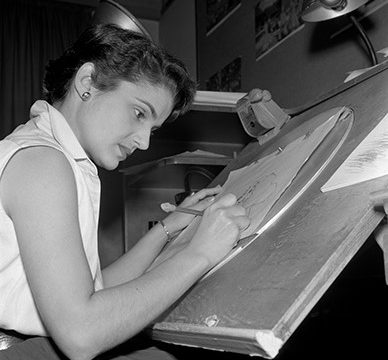It is much harder to research women who worked in Disney animation than men. The studio talked a lot about the Nine Old Men; in women, you get a certain discussion of Mary Blair, and that is pretty much it. Now, it’s true that a lot of classic animation comes from when you didn’t get credits at all—under half the crew of Snow White and the Seven Dwarfs were credited, and none of the cast. Still, even in later years, when Walt was teaching the general public about how animation works, he mostly had people like Ward Kimball. Who was great, don’t get me wrong, but it’s not an accurate portrayal of what the studio actually looked like behind the scenes.
Bea Tamargo is not one of those uncredited Snow White animators, in no small part because she was nine years old at the time. However, she would go on to be uncredited for Cinderella, Alice in Wonderland, Peter Pan, and Lady and the Tramp. Our image today is out of the Disney archives and shows her actually working on Lady and the Tramp, but she remains so left out of history that she isn’t even credited on IMDb—researching her has proved more difficult than most people because she has neither a Wikipedia page nor an IMDb page.
It’s especially a shame since it seems likely that Tamargo lived a fascinating life. She was born in Havana, Cuba, and her family moved to the US when she was a child. In addition to her artistic abilities, she would prove useful to the studio because she was able to serve as a translator. She seems to have been useful in Spanish-speaking visitors came to the studio to talk to Walt about things. Obviously, she wasn’t involved in El Grupo—see, again, born in 1928—but she would be helpful in the ’50s.
Disney was a considerably more diverse studio than Warners, and not just because of Walt’s weird belief that women had more “delicate” hands and were better suited to the Ink and Paint Department—where, indeed, Tamargo got her start at the studio. We’ve covered several people over the years who worked at Disney in its Golden Age who didn’t fit into the Nine Old Men mold for reasons of gender or ethnicity. That simply does not seem to have been the case at Warners, though I’d love to have it brought to my attention if I’m wrong about that.
Still, a lot of the women at Disney are glossed over as simply “the Ink and Paint Department,” even when Mary Blair convinced Walt to let women move away from that limited role at the studio. Indeed, most of the information I’ve found about Tamargo comes from an article on the official D23 website called “Women of Ink and Paint: Bea Tamargo.” Though the article mentions that she was an assistant animator, translator, dubber, and live-action model in her years there, which is a heck of a lot more than a lot of the men did.
Reward me for actually writing about those not often written about; consider supporting my Patreon or Ko-fi!

